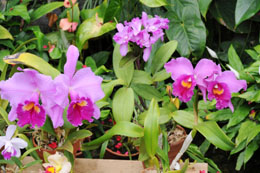Phalaenopsis orchid pruning is not only useful for controlling the plant's size and shape, but it also prepares it for the next flowering season. Learn how to prune this plant, and definitely, you can enjoy lovely blooms for the second time.

When it comes to maintaining Phalaenopsis or moth orchids, gardening enthusiasts are often confused with the specific care guidelines. Many of us have an impression that these plants are difficult to maintain, especially after the first blooming period is over; this is, however, not the case in reality. Moth orchids require indirect sunlight, warm temperature (70 - 80° F, during the day), moderate watering, good humidity (50 - 70 percent), and regular feeding for producing healthy blooms. You will be glad to know that timely pruning is a sure way to induce a bout of second flowering in these plants.
Tips on Pruning This Plant
Its significance lies in improving plant vigor, removing diseased parts, shaping the plant, controlling its size, and most importantly, inducing blooms after the first flowering season. If you are concerned about cutting spent flowers, do not worry, as it does not cause any adverse effects to this plant. Following are some instructions that will make it easier for you to trim off the plant parts correctly:
Ideal Time
The time for pruning matters a lot in maintaining healthy plants. As a thumb rule, trimming the plant parts is best done during the dormant period, so that it recovers easily with time. The best time to prune a Phalaenopsis orchid is late fall, when the environmental temperature is cool. By this time, you can identify the weak branches (if any) that need to be removed.
Pruning the Orchid
Before you proceed with it, be prepared with the right gardening tool (sharp shears or razor blade), and determine the old flowering stalk. Yellowish or brown coloration indicates that it will not develop new blooms. In such a case, you can cut the stalk about an inch above the point, where it meets the main stem. This helps in conserving energy so that the plant prepares itself for the coming blooming period.
Pruning to Induce New Blooms
This method is focused on encouraging the plant to produce blooms in the same flowering season. Over here, the pruning is suggested when the blossom stalk is still green in color. Ideally, you can proceed with it when there are some potential flowers in the twig. First identify the node in the stalk (the point where a green, foliage-like bract is attached), and cut the twig about ¼ inch above the nodal point.
Care
Provided that you make smooth cuts and do not injure the stem, your plant will recover quickly. In case of cutting the stalk completely, a new spike will shoot up in its place in the next flowering season. Nevertheless, if you are following the second option of pruning for encouraging new blooms, it is quite likely that the plant develops another flower twig very soon, may be within a month or so.
Thus, the best part for moth orchid is easy induction of flowers, which is quite challenging for other varieties. With healthy plants, avid gardeners succeed in inducing blooms for three times in a year. While pruning this plant, using correct tips ensures production of more flowers; you need to keep a watch for disease signs as damage twigs are susceptible to infections. The point is to make clean cuts with sharp tools.
With these easy maintenance requirements, this cultivar has become a popular choice of orchid for avid gardeners. In fact, it is the simplest one to plant at home, both indoors and outdoor gardens.






 When it comes to maintaining Phalaenopsis or moth orchids, gardening enthusiasts are often confused with the specific care guidelines. Many of us have an impression that these plants are difficult to maintain, especially after the first blooming period is over; this is, however, not the case in reality. Moth orchids require indirect sunlight, warm temperature (70 - 80° F, during the day), moderate watering, good humidity (50 - 70 percent), and regular feeding for producing healthy blooms. You will be glad to know that timely pruning is a sure way to induce a bout of second flowering in these plants.
When it comes to maintaining Phalaenopsis or moth orchids, gardening enthusiasts are often confused with the specific care guidelines. Many of us have an impression that these plants are difficult to maintain, especially after the first blooming period is over; this is, however, not the case in reality. Moth orchids require indirect sunlight, warm temperature (70 - 80° F, during the day), moderate watering, good humidity (50 - 70 percent), and regular feeding for producing healthy blooms. You will be glad to know that timely pruning is a sure way to induce a bout of second flowering in these plants.